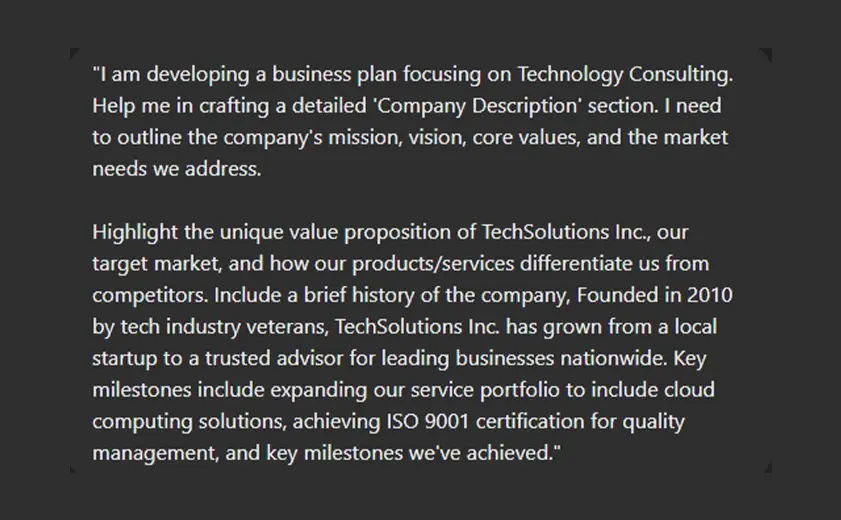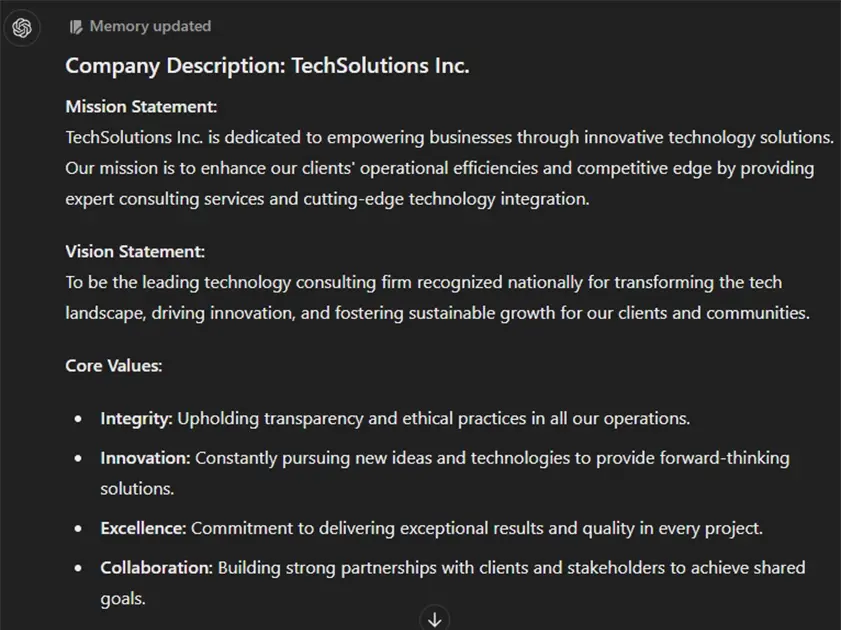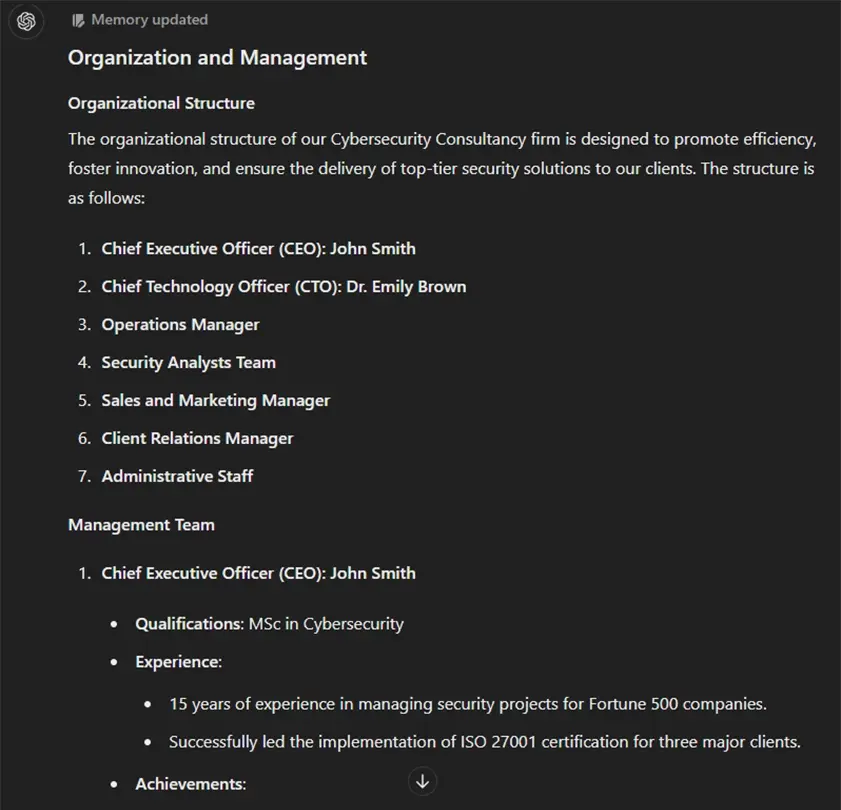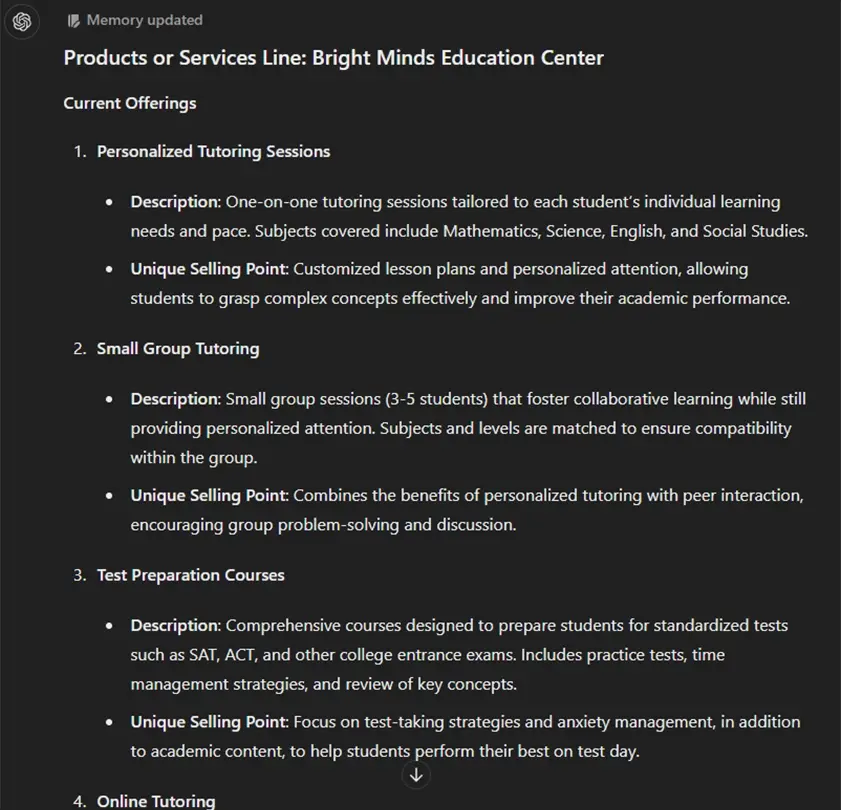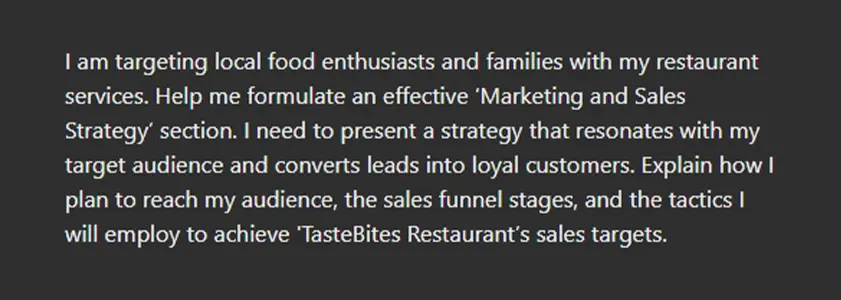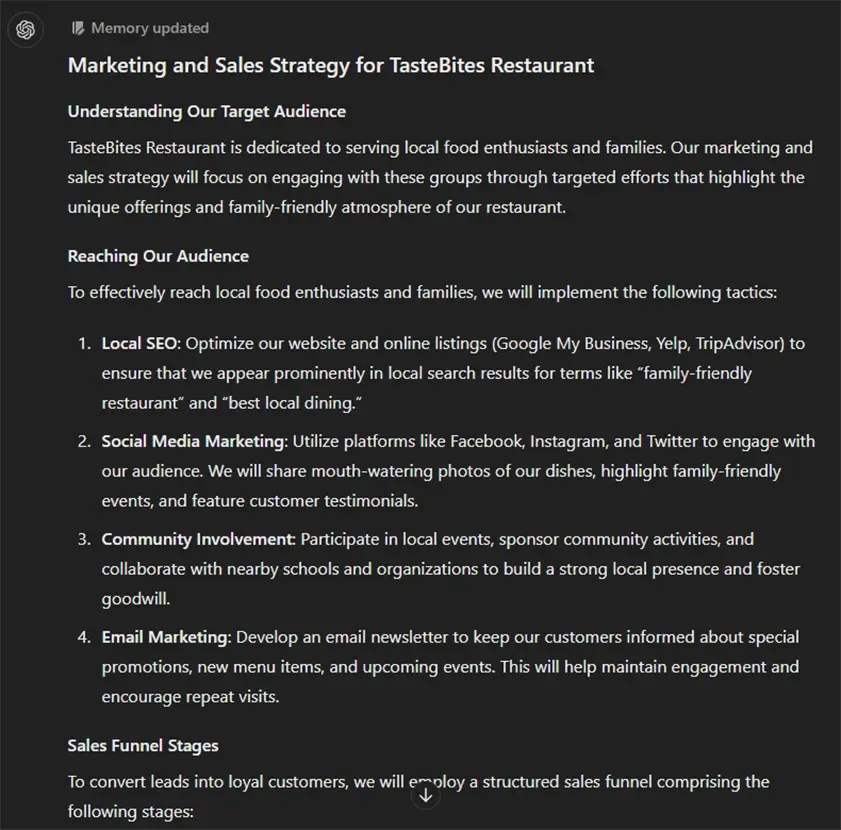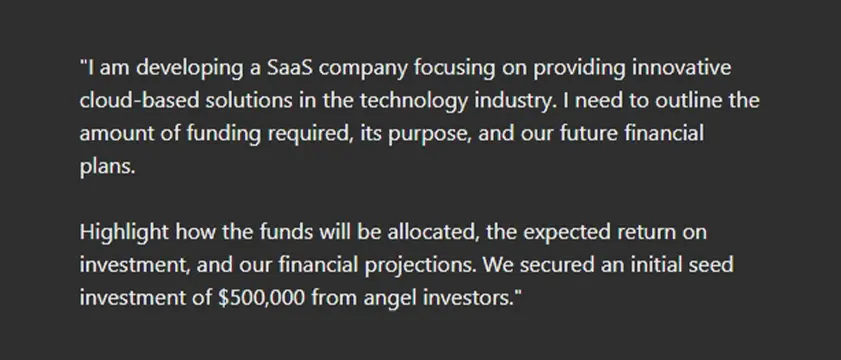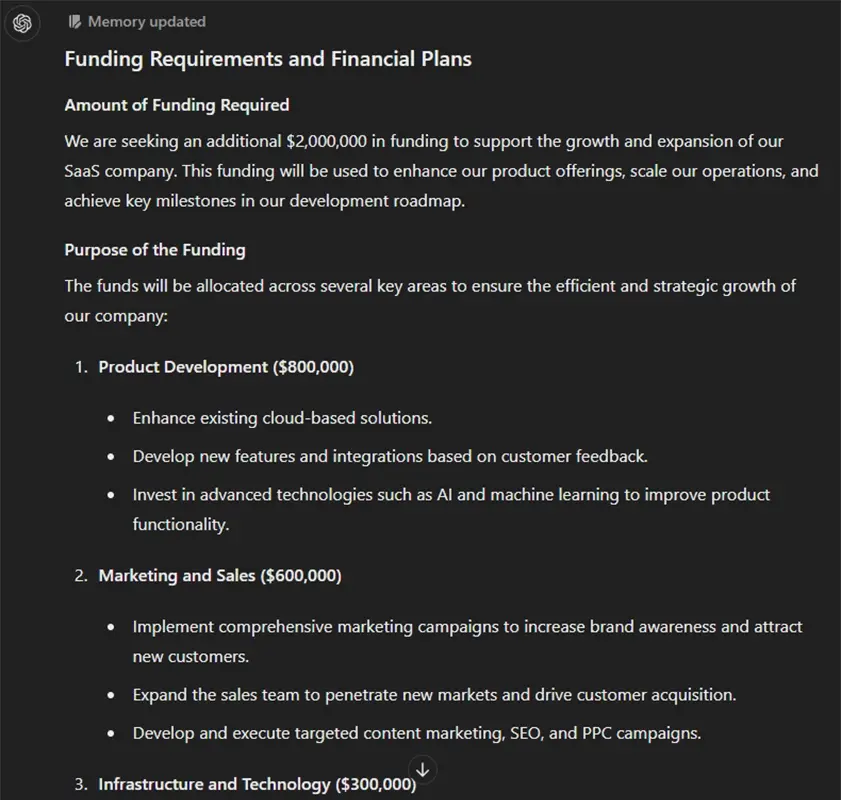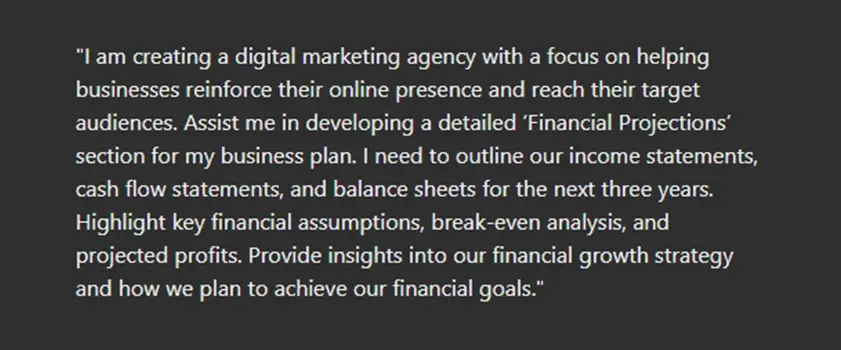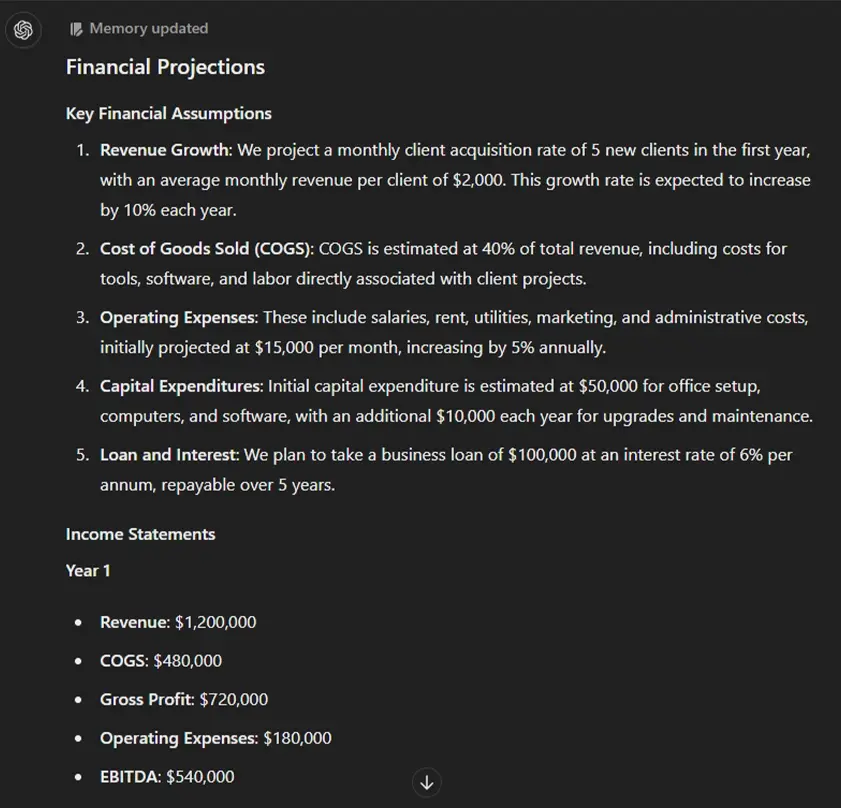In the world of business, turning ideas into a solid plan can be tough. But now, thanks to artificial intelligence (AI), this process is getting easier. AI prompts can help you take rough ideas and turn them into a well-organized business plan.
But what are these prompts like? This article explores the top AI prompts for writing a business plan with examples. They ensure all the important parts are included, from your market strategy to financial forecasts.
Plus, we'll show you common mistakes to avoid so your plan is polished and professional.
8 AI prompts for writing a business plan (based on business plan sections)
Here are 8 AI prompts you can use right now to start crafting your business plan as you read the blog:
1. Executive summary
So basically, an executive summary is an opening section of your business plan that covers all the essential aspects of your idea or company.
It’s like a summary that grabs the reader’s attention with key details. And guess what has powerful summarization abilities? An AI!
Once you've created other sections of your business plan—like your market analysis, product details, and financial projections— use AI to summarize all that information into a concise and impactful executive summary.
Prompt:
“Write an executive summary for a business plan. The business [name] is a startup offering innovative [solution/product] in its [industry]. Utilize the completed sections of the business plan provided below to summarize with specific details. The key points to cover in the executive summary include:
- Company overview: Briefly describe the business, including its name, location, and products or services.
- Mission statement: Outline the mission and vision of the business.
- Market opportunity: Highlight the market need or problem your business addresses, including target market and industry analysis.
- Business model: Explain how the business intends to make money, including revenue streams and pricing strategy.
- Team: Introduce the members of the team and their relevant experience.
- Financial projections: Summarize the financial aspect of the business, including projected revenue, profit margins, and funding requirements.
- Goals and milestones: Outline the short-term and long-term goals of the business, along with key milestones to be achieved.
Above are the details of other sections of the plan that can be used to frame the business plan:
Further prompt:
"Write a mission statement for your company that outlines its objectives and purpose. Consider the following elements: What does your company strive to accomplish? How does it differentiate itself in the market? “
Example:
“Write an executive summary for a business plan. The business SwiftEats is a startup offering an innovative food delivery platform that connects users with local restaurants through its food delivery services. Utilize the completed sections of the business plan provided below to summarise with specific details. The key points to cover…..
Note: This section should be written after all other sections of the business plan are completed. It serves as a summary and can be effectively created using AI to ensure it covers the key points clearly and effectively.
2. Company description
Now this section of your business plan provides an overview of your business, detailing what your company does, the market needs it addresses, and its unique value proposition.
It's important to convey a clear and compelling description of your company to capture the interest of potential investors and stakeholders.
Prompt:
"I am developing a business plan focusing on [industry]. Help me in crafting a detailed 'Company Description' section. I need to outline the company's mission, vision, core values, and the market needs we address.
Highlight the unique value proposition of [business name], our target market, and how our products/services differentiate us from competitors. Include a brief history of the company, [company history details], and key milestones we've achieved."
Example usage:
Prompt
Response
3. Market analysis
This section of your business plan describes the market you’re selling to. Market analysis is one of the important factors as it shows your understanding of the industry and market. It should detail the target market, market trends, and competitive landscape.
Remember that market analysis relies on current and up-to-date information, which AI might not always provide accurately due to the rapid changes in market conditions. We recommend you verify the data that AI provides for accuracy and relevance.
Prompt:
"I am creating a [business type] in the [industry]. Assist me in developing a detailed 'Market Analysis' section for my business plan. I need to outline the target market, industry trends, and competitive landscape.
Highlight key market statistics, demographic details, and how our products/services will meet the market demands. Provide insights into our competitors, their strengths, and weaknesses, and how we plan to position ourselves in the market."
Example usage:
Prompt
Response
4. Organization and management
This section of the business plan is the most important one which outlines the company and its team members. Here you should ensure that there’s no mistake in the information provided in the team details.
The final output will be generated based on this data, so you should present the key details very transparently.
Prompt:
“I am structuring a [business type] with a focus on [industry]. Assist me in developing a detailed “Organization and Management” section for my business plan. I need to outline the organizational structure and the management team’s expertise.
Highlight the qualifications and past achievements of my team members, [team member descriptions], and how their experience will contribute to the success of [business name].”
Example usage:
Prompt
Response
5. Products or services line
Here, you as an entrepreneur show the market what you’re offering through your business. This section should clearly differentiate your products or services and their value proposition.
It outlines the competitive advantages that set your offerings apart in the market and shows how they address specific customer needs.
Prompt:
“I am offering [product/service description] in the [market/industry]. Guide me in creating a detailed “Products or Services Line” section. I need to showcase the uniqueness of my offerings and how they stand out in the marketplace. Describe the development stage of my products/services and the roadmap for future offerings for [business name].”
Example usage:
Prompt
Response
6. Marketing and sales strategy
The Marketing and Sales Strategy section outlines how you plan to attract and retain customers.
It should detail how you will convert leads into customers. This includes your sales process, pricing strategy, sales team structure (if applicable), and any incentives or promotions to encourage purchases.
Prompt:
I am targeting [target market] with my [product/service]. Help me formulate an effective “Marketing and Sales Strategy” section. I need to present a strategy that resonates with my target audience and converts leads into loyal customers. Explain how I plan to reach my audience, the sales funnel stages, and the tactics I will employ to achieve [business name]'s sales targets.
Example usage:
Prompt
Response
7. Funding request
In this section, specify the amount of funding required, how you’ll utilize it, and your future financial plans. It provides potential investors with a clear understanding of why you need the funding and how it will contribute to the growth and success of your business.
Be specific about the purposes for which the funds will be allocated, whether it's for product development, marketing campaigns, hiring personnel, or expanding operations.
This section aims to instill confidence in stakeholders about the viability of your business and the potential returns on their investment.
Prompt:
"I am developing a [business type] focusing on [industry]. Assist me in crafting a detailed 'Funding Request' section for my business plan. I need to outline the amount of funding required, its purpose, and our future financial plans.
Highlight how the funds will be allocated, the expected return on investment, and our financial projections. Provide [Details] on any previous funding received and our current financial status."
Example usage:
Prompt
Response
8. Financial projections
The financial projections section of your business plan presents a forward-looking view of your company's financial performance. It includes forecasts for income statements, cash flow statements, and balance sheets, typically covering a period of one to five years.
These projections are based on assumptions about market conditions, sales growth, costs, and other factors to your business operations.
Prompt:
"I am creating a [business type] with a focus on [industry]. Assist me in developing a detailed 'Financial Projections' section for my business plan. I need to outline our income statements, cash flow statements, and balance sheets for the next [number] years.
Highlight key financial assumptions, break-even analysis, and projected profits. Provide insights into our financial growth strategy and how we plan to achieve our financial goals."
Example usage:
Prompt
Response
Common mistakes to avoid when using AI to write a business plan
When using AI to write a business plan, it's important to be mindful of the common mistakes that are likely to occur.
By focusing on these mistakes it helps to keep your plan remains accurate, comprehensive, and true to your business goals. Here are some key mistakes to avoid:
1. Over-relying on AI
Depending on AI can make your plan generic rather than unique. Each business has its own set of challenges, opportunities, and competitive landscape, and making a personalized approach is important for standing out in the market.
While AI can generate content and structure, it's essential to add your personal insights and industry knowledge to make the plan authentic and relevant.
2. Skipping thorough review
Always review and revise the AI-generated content. Check for accuracy, relevance, and alignment with your business objectives.
AI can make mistakes or provide outdated information because of its fed data and can contain limited current information.
3. Support your claims
While AI-generated content can appear impressive and accurate, it's essential to conduct thorough verification.
Supporting your claims is important when using AI for business planning because it may not always use credible sources or can even create information. Using reputable sources strengthens your arguments and helps build trust with investors and stakeholders.
4. Neglecting financial details
AI can help with projections, but you need to ensure the financial details are accurate and based on realistic assumptions.
AI algorithms rely on the data they’re trained on, which may not always reflect current market conditions. Therefore, it's important to double-check the projections to make sure they align with your actual financial situation and business goals.
Conclusion
Using AI to create a business plan can help organize and outline your ideas efficiently. However, it's important to use AI tools wisely. While they can organize information well, they might not fully understand the specific details and insights that make your business unique.
However, using an AI business plan creator can speed up the initial planning stages. By combining AI's organizational power with your expertise, you can create a strong and compelling business plan in no time.
Get Your Business Plan Ready In Minutes
Answer a few questions, and AI will generate a detailed business plan.
Frequently Asked Questions
What is the benefit of using AI for business planning?
The benefit of using AI for business planning lies in its ability to maintain structure and ease the writing process. AI can organize complex information, suggest logical sequences for business plans, and automate repetitive tasks like data analysis and report generation.
Therefore, AI is known for its productivity and accuracy in business planning by handling routine tasks and ensuring a well-structured plan
Are there any specific AI tools recommended for business planning?
There are several AI tools designed to assist with business planning, each offering unique features to help streamline the process. Notable examples include Bizplanr, Upmetrics, LivePlan, and many more that use AI to simplify complex tasks and improve efficiency.
How accurate are AI-generated business plans?
AI-generated business plans can be quite accurate if they’re trained on relevant and high-quality data. However, they might not always account for unexpected changes or human intuition that can be important in business planning.
Can AI help with financial projections in a business plan?
Yes, AI can assist with financial projections by analyzing historical data, market trends, and other factors to forecast future financial outcomes more accurately. It uses this information to forecast how much money the business might make and spend.
AI can also create different scenarios to see how decisions might affect finances. It can analyze risks and automate tasks to make financial planning more accurate and efficient.
What are the limitations of using AI for business planning?
AI relies heavily on the quality of the data it's trained on. If the data is incomplete, biased, or not relevant, AI may produce inaccurate or misleading results. Also, AI may not understand human factors or changes in the business environment that can affect planning.


